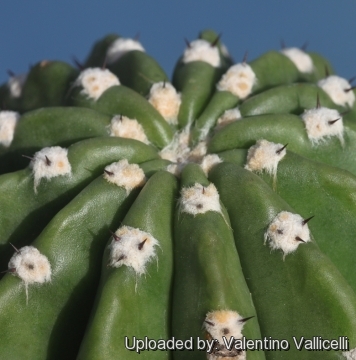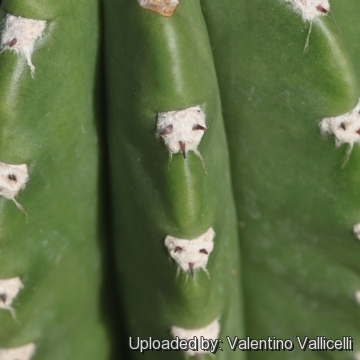Donate now to support the LLIFLE projects.
Your support is critical to our success.
Your support is critical to our success.
Accepted Scientific Name: Echinopsis atacamensis subs. pasacana f. brevispina hort.

Trichocereus pasacana f. brevispinus (Echinopsis atacamensis subs. pasacana f. brevispina) Photo by: Valentino Vallicelli
Synonyms:
See all synonyms of Echinopsis atacamensis
back
Accepted name in llifle Database:Echinopsis atacamensis (Phil.) H.Friedrich & G.D.Rowley
I.O.S. Bull. 3(3): 94. 1974
Synonymy: 9
- Echinopsis atacamensis (Phil.) H.Friedrich & G.D.Rowley
- Cereus atacamensis Phil. in Phil.
- Helianthocereus atacamensis (Phil.) Backeb.
- Trichocereus atacamensis (Phil.) W.T.Marshall & T.M.Bock
- Echinopsis atacamensis f. eremophilus (F.Ritter)
- Trichocereus eremophilus F.Ritter
- Echinopsis rivierei (Backeb.) H.Friedrich & G.D.Rowley
- Leucostele rivieri Backeb.
- Trichocereus rivierei (Backeb.) Krainz
Echinopsis atacamensis subs. pasacana (F.A.C.Weber ex Rümpler) G.Navarro
Lazaroa 17: 54. 1996
Synonymy: 11
- Echinopsis atacamensis subs. pasacana (F.A.C.Weber ex Rümpler) G.Navarro
- Cephalocereus pasacanus (F.A.C.Weber ex Rümpler) F.A.C.Weber
- Cereus pasacana (F.A.C.Weber ex Rümpler) F.A.C.Weber
- Echinopsis pasacana (F.A.C.Weber ex Rümpler) H.Friedrich & G.D.Rowley
- Helianthocereus pasacanus (F.A.C.Weber ex Rümpler) Backeb.
- Pilocereus pasacanus F.A.C.Weber ex Rümpler
- Trichocereus atacamensis var. pasacanus (F.A.C.Weber ex Rümpler) F.Ritter
- Trichocereus pasacana (F.A.C.Weber ex Rümpler) Britton & Rose
- Trichocereus pasacanus (F.A.C.Weber ex Rümpler) Britton & Rose
- Echinopsis cephalopasacana (Frič)
Echinopsis atacamensis subs. pasacana f. brevispina hort.
Synonymy: 3 Accepted name in llifle Database:
Echinopsis atacamensis subs. pasacana f. cristata hort.
Synonymy: 3
back

Trichocereus pasacana f. brevispinus (Echinopsis atacamensis subs. pasacana f. brevispina) Photo by: Valentino Vallicelli

Trichocereus pasacana f. brevispinus (Echinopsis atacamensis subs. pasacana f. brevispina) Photo by: Valentino Vallicelli
| Your Actions | |
|---|---|
| Back to Trichocereus index | |
| Back to Cactaceae index | |
 |
Back to Cacti Encyclopedia index |








